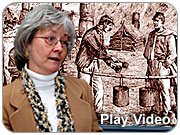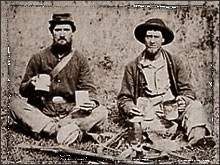A TASTE OF CIVIL WAR FOOD
Sampling Jaw-Cracking Hardtack, Hospital Gingerbread and "Idiot's Delight"
By Hoag Levins
CAMDEN, N.J. -- The Camden County Historical Society's recent 19th-century food history event certainly brought to mind that famous adage about how an army marches on


|
| Historical Society programming director Sandy Levins gives a short video presentation about the authentic Civil War foods researched and prepared by Society volunteers. | its stomach. The saying was never truer than during the American Civil War, as huge numbers of soldiers marauded across vast expanses of territory to wage North America's most savage military conflict.
The food supply
Through it all, the morale, as well as the physical stamina of each combatant, was directly dependent on what he had to put in his mouth each day. The quartermasters who oversaw the food supply for both the Union and Confederate armies were among those organizations' most important officers because if they failed, the entire army could literally collapse from hunger.
Quartermaster duties were among the military's most complex tasks. Vast tonnages of food and other supplies had to be constantly acquired, secured and moved in a highly organized manner across often-impossible terrain under the most chaotic and harrowing of conditions. The job required particularly talented and driven individuals. For instance, General Ulysses S. Grant, who ultimately led the Union forces to victory, spent much of his earlier military career as a quartermaster rather than an infantry or cavalry leader.
| Click for Larger
|

|
| Hardtack
|

|
| Gingerbread
|

|
| Applesauce Cookies
|

|
| Idiot's Cake
|

|
| Corn Muffins
|

|
| Lincoln Cake |

|
| Orange Cake
|
Stark realities
At the bottom of the logistical chain, gathered around a hundred thousand campfires each day, were the individual soldiers who needed to be fed. In an era before refrigeration or modern food processing techniques, they had to make do with the best fare that could be gotten through to them or on what they could forage from the surrounding landscape.
Although, by today's standards, most of their living and eating conditions were incredibly harsh, many of the baked goods they commonly ate were surprisingly tasty -- a fact learned first hand by those who attended the Camden County Historical Society's recent "Women at the Battle of Gettysburg" presentation.
As part of that Jane Peters Estes event, attendees were invited to try a taste of authentic Civil War food as they listened to the details of the women involved at Gettysburg.
Hunger and horror
"It all seemed to work together because so much of the story of Gettysburg was about how the soldiers endured both hunger and horror at the same time much of the town's female population was turned into cooks and nurses in the midst of incredible carnage and need," said Historical Society director of programming Sandy Levins. "The idea was to enable the audience to become part of what they were listening to by actually sampling some of what would have brought comfort and sustenance to those Civil War soldiers."
Six Historical Society volunteers researched recipes for period foods and conducted trial baking runs before preparing the food spread across two tables in the rear of the Boyer Auditorium at Society headquarters.
Ms. Levins explained some of the items for the audience:
"Corn meal was an important staple for both armies and soldiers would have eaten corn bread and jonny cake. Our mini-corn muffins today are a nod to that tradition," she said.
Hospital Gingerbread
Gingerbread was also a favorite when it was available, and a comfort food often offered to wounded soldiers in field hospitals. One diary entry of a Civil War nurse described how, after spending the day bathing and bandaging soldiers wounds, she found a sutler's stand and bought a supply of gingerbread which she called "a singular food for sick men."
However, Mrs. Levins pointed out, the conflict's food history "was not all about goodness and light. During the war the four items that caused the most food-related fights within the ranks were bread, meat, apples and pickles. Documents record that soldiers were court martialed, beaten almost to death, and even shot over apples as they went foraging. These were desperate times when large numbers of men often lived just this side of starvation for long periods of time."
The most common -- and likely the most hated -- of all their foods was hardtack, she said. "It was the one thing that every soldier carried in his rucksack. Basically, it was a simple cracker made of flour and water, mixed and rolled to a thickness of about 3/8 of an inch. It was cut into squares and poked with a fork to speed baking time. It's been described by the men as 'indestructible, imperishable, practically inedible, too hard to chew, too small for shoeing mules and too big to use as bullets.'"
One of the best-tasting foods in the afternoon's display was a deep-dish, dark brown float of biscuit-like objects in a thick cinnamon-raisin sauce. The sweet treat was known as "Idiot's Delight," because, Ms. Levins explained, "It was so simple to put together with readily-available materials that it was said 'even an idiot' could make it."
Luxury of coffee
She also emphasized that the coffee being served that afternoon was an item of great luxury for many of the combatants. "Much like today, the men on both sides of the war loved their coffee. The Union was

|
| Coffee shortages were a plague of the Civil War, particularly for Confederate troops. They were often forced to brew chicory, burnt corn, peas, potatoes, peanuts and even acorns instead. |
fortunate to have a steady supply of coffee beans, although they were raw and green and had to be roasted over an open fire without being burnt. Then they were cracked with rifle butts before they could be used for brewing."
"The Confederacy," she said, "was not so lucky. Blockades impeded its flow of equipment and arms as well as food, and its soldiers were forced to make due with things like chicory, burnt corn, peas, potatoes, peanuts and even acorns they would forage in the fall and winter."
Hovering close by the food tables, Historical Society president Richard Pillatt noted "it does seem fitting that as we gather here to contemplate what happened at Gettysburg in 1863, we are also munching on these tooth-cracking plugs of hardtack. As you try to chew this stuff, it really gives you a new appreciation of how difficult even the most minor aspects of daily life must have been for those men and women who sacrificed and suffered so much for the country during those dark days."
The foods for the event were provided by Joyce Albrecht, Dale Chimel, Sandra Forney, Linda Gentry, Charla Lewis, Cheryl McClain and Kathy Witzig.
All Rights Reserved © 2006, Hoag Levins
HoagL@earthlink.net
About this Web site
| 












